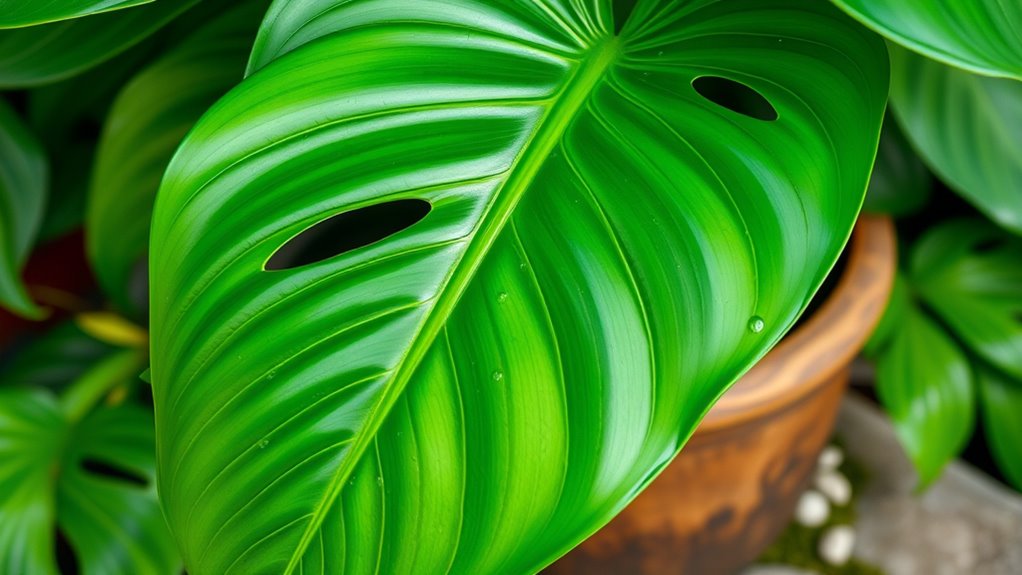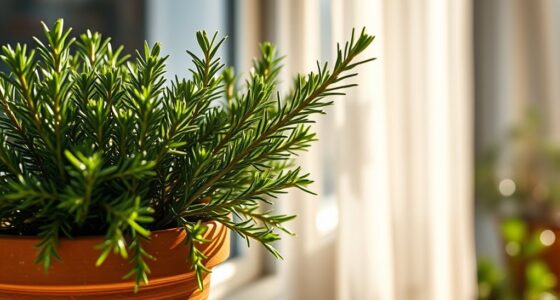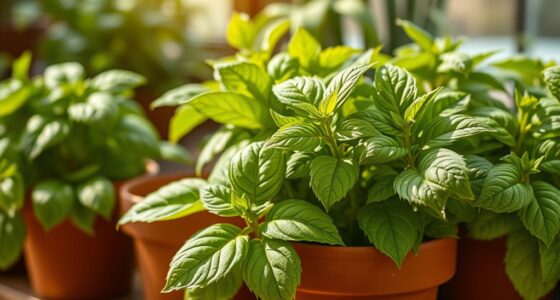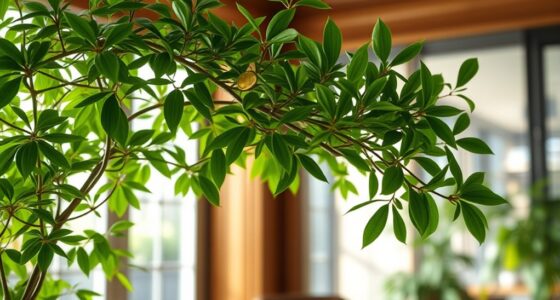For lush Monstera deliciosa growth, provide bright, indirect light for 6–8 hours daily, keeping it near east- or north-facing windows. Use well-draining soil, like peat and perlite, in a pot with drainage holes, and water only when the top inch of soil dries out. Maintain high humidity (60-80%) and warm temperatures, and fertilize every 3–4 weeks during active growth. Support tall or climbing varieties and watch for pests to keep your plant thriving—learn more with each tip.
Key Takeaways
- Provide bright, indirect light for 6-8 hours daily and rotate regularly to promote fenestration.
- Maintain high humidity (60-80%) and stable temperatures between 65°F-85°F for optimal growth.
- Use well-draining soil and pots with drainage holes, repot every 2-3 years or when roots are crowded.
- Water only when the topsoil is dry, fertilize every 3-4 weeks during active growth, and propagate via stem cuttings.
- Control pests promptly, remove dead leaves, and support top-heavy growth with stakes or moss poles.
Optimal Lighting Conditions for Monstera Deliciosa

To help your Monstera Deliciosa thrive, providing the right lighting is essential. Aim for bright, indirect light—about 6-8 hours of filtered light daily—to encourage healthy growth and develop those characteristic fenestrated leaves.
Placing your plant near east- or north-facing windows offers gentle morning light, which supports fenestration without risking leaf scorch. Avoid direct afternoon sun, as harsh rays can cause leaf burn and yellowing. Using a self watering plant pot can also help maintain consistent soil moisture, which is beneficial for healthy leaf development. Additionally, understanding optimal lighting conditions can significantly impact your plant’s growth and fenestration quality.
Place your Monstera near east- or north-facing windows for gentle morning light that encourages fenestration without leaf scorch.
If the light is too dim, your Monstera may produce smaller, less fenestrated leaves and grow more slowly. To ensure even light exposure, rotate your plant regularly. This helps promote symmetrical fenestration and vibrant foliage, making your Monstera look lush and healthy.
Proper lighting is key to beautiful, thriving growth, especially since lighting conditions significantly impact the development of fenestration and overall plant health.
Choosing the Right Soil and Pot for Healthy Roots

To keep your Monstera healthy, select a well-draining soil mix with peat, perlite, and shredded bark for proper aeration and moisture balance. Use a porous pot like terracotta or ceramic to help excess water evaporate and prevent root rot. Make sure the pot is slightly larger than the root ball to give your plant room to grow. Additionally, choosing a container that promotes proper airflow can further support healthy root development. Incorporating adequate drainage holes in the pot can also prevent water from pooling and ensure optimal root health. Implementing AI-powered soil monitoring tools can help you maintain ideal moisture levels and promote lush growth.
Soil Composition Needs
Choosing the right soil and pot is essential for your Monstera Deliciosa’s healthy growth. Use a well-draining soil mix made of three parts indoor potting soil, two parts shredded bark, and one part perlite to guarantee proper aeration and moisture control. Regularly inspecting the condition of the soil and pot can help prevent issues such as waterlogging or root rot. Select a pot with drainage holes, preferably made of porous materials like terracotta or ceramic, to prevent water from accumulating around the roots. Incorporate organic matter such as compost or peat into the soil to supply essential nutrients for root development. Maintain a slightly acidic to neutral pH level, around 6.0 to 7.0, for ideal nutrient uptake. Proper installation and ventilation are also important to ensure the plant’s environment remains healthy. Using appropriate soil composition can significantly enhance root health and overall plant vitality. Additionally, ensuring proper watering practices helps maintain soil moisture without overwatering. Regularly refresh or amend the soil every 2-3 years, especially after repotting or if the plant shows signs of stress, to keep it healthy and vibrant. Providing adequate light conditions also supports the plant’s growth and nutrient absorption.
Proper Drainage Tips
Ensuring proper drainage is essential for maintaining healthy Monstera Deliciosa roots. Start with a pot that has drainage holes, allowing excess water to escape and preventing water retention that can lead to root rot.
Choose porous pots like terracotta or ceramic to improve soil drainage and airflow. Layer the bottom with gravel or clay pebbles to further enhance water flow and stop soil compaction around the roots. Incorporating effective drainage systems can further prevent overwatering issues.
Use well-draining soil, blending equal parts peat-based soil, shredded bark, and perlite to create an airy mix with ideal soil drainage. Keep soil pH between 6.0 and 7.0, which supports nutrient uptake and root health.
Avoid dense, heavy soils, and opt for light, breathable mixes that promote healthy root growth. Regularly check the moisture level to prevent overwatering, and consider incorporating air filtration techniques to maintain optimal soil and air quality around your plant.
Ideal Pot Materials
Selecting the right pot material is essential for maintaining healthy Monstera Deliciosa roots, as it influences moisture regulation and airflow. Terracotta and ceramic pots are excellent choices because their porous materials allow excess moisture to evaporate, promoting proper aeration and reducing the risk of root rot. Additionally, choosing pots with adequate drainage holes is crucial to prevent water from accumulating at the bottom, which can lead to root problems. Always choose pots with drainage holes to prevent waterlogging, and add a layer of gravel or clay pebbles at the bottom for enhanced drainage. Use well-draining soil mixes that combine peat-based components with perlite or pumice to ensure proper aeration and avoid soggy roots. Match your pot size to your plant’s largest leaf diameter, typically one or two inches wider, to support healthy root growth and prevent overcrowding. Ensuring proper soil aeration is vital for the overall health of your Monstera and helps prevent issues like root rot. Incorporating proper drainage techniques is also key to maintaining a healthy root environment. Additionally, selecting appropriate pot materials can significantly influence moisture retention and root health. Being aware of market trends and how they impact plant supply and demand can also help you acquire healthy, well-cared-for specimens. Furthermore, understanding the climate conditions of your area can guide you in choosing the best pot and soil setup for optimal growth.
Proper Watering Techniques to Prevent Over- and Underwatering
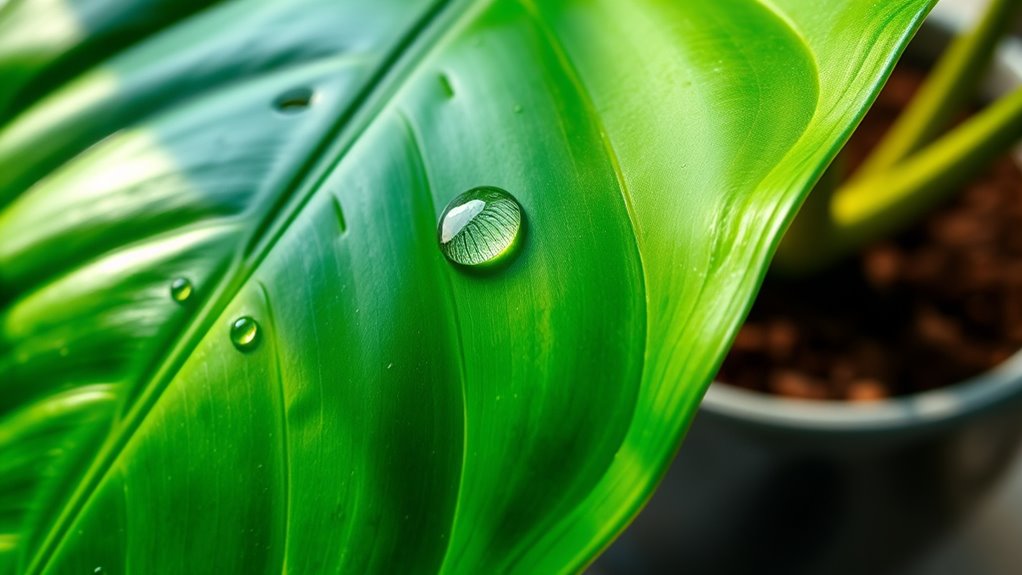
To keep your Monstera Deliciosa healthy, it’s vital to water it properly and avoid over- or underwatering. Check the topsoil; only water when the top 1-2 inches dry out. Slow, deep watering ensures moisture reaches the roots effectively. Using a pot with drainage holes helps prevent water from pooling and causing overwatering, which can lead to root rot. Adjust your water frequency based on the season: increase during spring and summer, and reduce in fall and winter when growth slows. Watch for signs of overwatering, like yellowing leaves, or underwatering, such as leaf curling and browning edges. Proper watering keeps the roots healthy, promotes lush growth, and avoids common issues caused by improper soil moisture levels. Incorporating well-draining soil and monitoring air quality can further support your plant’s health. Additionally, understanding the watering requirements of your Monstera can help you develop a more tailored care routine. Recognizing the importance of soil moisture can prevent root problems and ensure consistent growth.
Maintaining Ideal Humidity and Temperature Levels
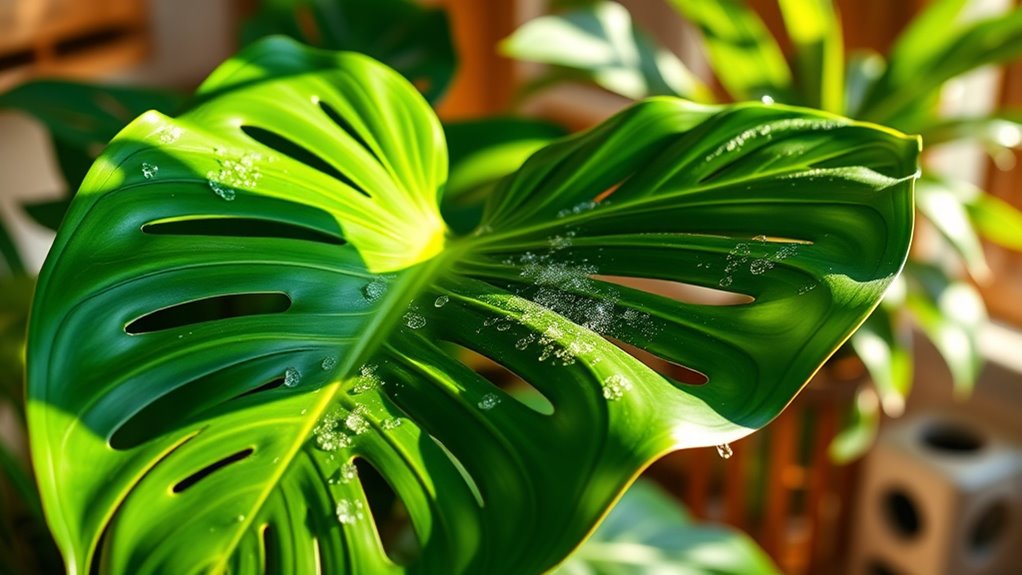
To keep your Monstera healthy, you need to maintain humidity levels between 60% and 80%. Stable temperatures between 65°F and 85°F are essential for vibrant foliage and proper growth.
Using a humidifier or misting during dry periods can help you achieve these ideal conditions.
Optimal Humidity Range
Monstera deliciosa thrives best when the humidity levels stay between 60% and 80%, mimicking its native rainforest environment. Maintaining this ideal humidity prevents leaf browning and encourages healthy fenestrations in mature leaves. You can achieve this by using a humidifier or misting the leaves regularly, especially in dry or heated spaces. Placing your plant on a tray with water and pebbles or grouping it with other plants helps create a microenvironment that boosts humidity. Monitoring humidity with a hygrometer ensures levels stay within the perfect range. Regularly cleaning your environment’s filtration systems can also help maintain optimal humidity and air quality for your Monstera. Being aware of air circulation is important, as stagnant air can lead to issues like mold or pests. Here’s a quick overview:
| Method | Benefits | Tips |
|---|---|---|
| Humidifier | Raises overall humidity | Use in dry climates |
| Misting | Directly increases moisture | Mist leaves weekly |
| Water & Pebbles | Creates microenvironment | Keep water topped up |
Keeping humidity levels consistent supports lush, vigorous growth.
Temperature Stability Tips
Maintaining stable temperatures is essential for healthy Monstera deliciosa growth, especially since sudden fluctuations can cause stress or damage. Keep your indoor climate consistent by monitoring the temperature, aiming for 65°F to 85°F. Use a thermostat or temperature monitor to prevent fluctuations beyond 5°F, ensuring thermal stability.
Be mindful of humidity levels—raising humidity to around 60% with humidifiers or pebble trays helps counteract dry air, especially in winter. Avoid placing your plant near cold drafts, air conditioning vents, or heating sources that can cause abrupt temperature drops.
Good air circulation also helps regulate temperature and humidity evenly. During colder periods, a space heater or radiant heat source can help stabilize the environment, but don’t let it dry out the air excessively.
Fertilization Strategies for Vigorous Growth

Fertilizing your Monstera deliciosa every 3 to 4 weeks during its active growing season encourages vigorous growth and the development of signature fenestrated leaves.
Use a balanced liquid fertilizer, such as 1-1-1 or 3-1-2, diluted to half strength, to provide essential nutrients. Incorporate this fertilizer into your watering routine by replacing some regular water with the solution, ensuring a consistent nutrient supply.
This regular feeding supports plant vigor and helps the Monstera grow lush, healthy foliage. Be mindful to reduce or pause fertilization during fall and winter when growth naturally slows.
Using water-soluble fertilizers prevents salt buildup and promotes quick absorption, giving your plant the ideal growth boost it needs during its active season.
Supporting Your Monstera With Poles and Climbers

Choosing the right support helps your Monstera grow strong and develop its signature leaves.
Training it to climb properly guarantees even growth and prevents toppling.
Regularly maintaining and adjusting the support keeps your plant stable as it gets taller.
Choosing the Right Support
To support your Monstera deliciosa as it grows taller and develops larger leaves, selecting the right support system is essential. A sturdy support, like a moss pole or natural support structure, mimics its rainforest environment and encourages climbing.
Guarantee the support is tall enough for your plant’s mature size. Gently secure aerial roots to the support with soft plant ties or clips to promote attachment and vertical growth.
Regularly mist or water the moss pole to keep it moist, encouraging aerial root adhesion. Using a breathable material, such as natural fibers or moss, helps maintain airflow and prevents rot.
Proper support prevents legginess and fosters the development of those iconic, fenestrated leaves, helping your Monstera thrive and grow lushly.
Training for Proper Climbing
Training your Monstera to climb effectively involves guiding its aerial roots and vines toward sturdy supports like moss poles or trellises. During repotting, place these supports and secure the plant’s aerial roots and vines loosely with plant ties or soft clips. This helps encourage climbing and supports healthy growth. Keep the support moist by misting or watering regularly, which promotes aerial root attachment and upward growth. Check ties often and adjust as your Monstera grows, ensuring stems are well-supported without constriction. Proper training enhances your plant’s growth pattern, resulting in larger, fenestrated leaves. Use the following table for quick reference:
| Support Types | Tips for Training |
|---|---|
| Moss Poles | Keep moist; guide aerial roots |
| Trellises | Secure loosely with ties |
| Plant Ties | Adjust regularly for growth |
Maintaining Support Stability
Supporting your Monstera with sturdy poles or trellises is essential for support stability and healthy growth. Use tall moss poles or climbing support structures that can accommodate your plant’s vertical growth.
Secure aerial roots and main stems loosely with soft plant ties or velcro strips to prevent damage while guiding the plant upward. Keep the support moist by misting or watering regularly; this encourages aerial roots to attach and climb more effectively.
Position the support early during repotting or pruning to help shape the plant’s natural climbing instinct and promote fenestration. Regularly check and adjust the ties as your Monstera grows to prevent constriction, ensuring ongoing plant stability and ideal development.
Proper support maintains a healthy, lush Monstera.
Propagation Methods to Expand Your Plant Collection
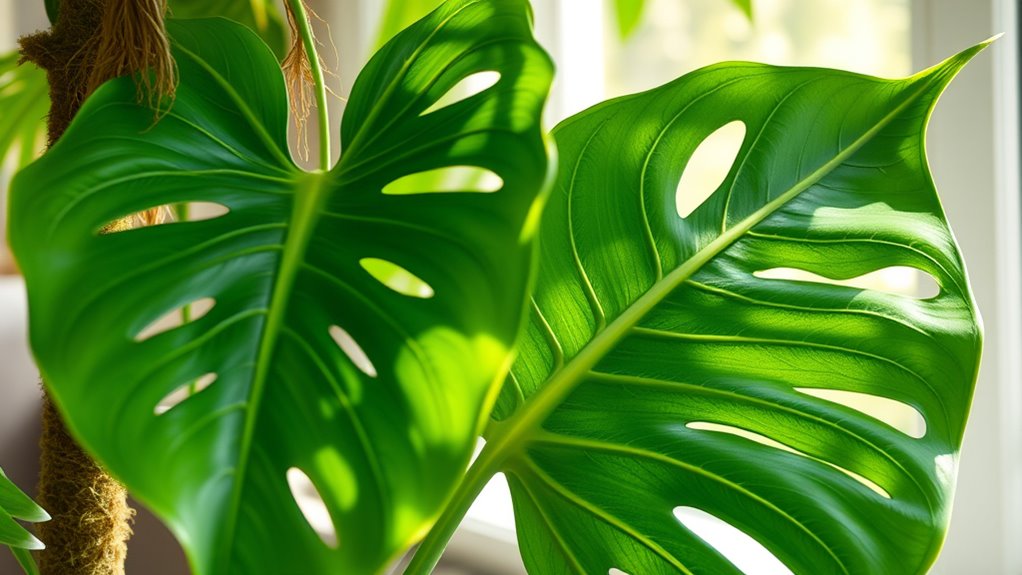
Propagating your Monstera deliciosa is an effective way to expand your plant collection and enjoy more of its lush foliage. To do this, follow these essential steps:
- Take stem cuttings with at least one node and aerial roots, using sterilized scissors just below the node.
- Decide whether to root in water or soil—submerge the aerial root and node in water or plant in moist moss or well-draining soil.
- Keep the environment bright, warm, and humid; roots typically develop in 2-4 weeks. For water rooting, change the water every 5-7 days until roots reach 2-3 inches before transplanting into soil.
This propagation method guarantees healthy growth and helps you create multiple Monstera plants for your space.
Repotting and Pot Size Selection for Mature Plants

When repotting your mature Monstera, choosing the right pot size is essential for healthy growth. Select a container that’s 2-4 inches larger in diameter than the current pot to support root growth without crowding.
Choose a pot 2-4 inches larger in diameter for healthy Monstera growth.
Confirm the new pot has drainage holes to allow excess water to escape, preventing root rot. Use well-draining soil and porous materials like terracotta or ceramic to promote airflow around the roots.
During the repotting process, gently loosen the root ball and position the plant at the same depth as before. Fill the new container with fresh soil and support the plant with stakes if needed.
Repot your mature plant every 2-3 years when roots become visible through drainage holes or the plant becomes top-heavy, ensuring ideal health and growth.
Common Pests and Diseases and How to Manage Them

Monstera plants are susceptible to several common pests and diseases that can compromise their plant health if not addressed promptly. Pests like scale, mealybugs, spider mites, aphids, and thrips often appear as sticky residue, webbing, or tiny insects on leaves and stems.
To manage these, you should:
- Regularly wipe leaves with a damp cloth or use insecticidal soap and neem oil for effective pest control.
- Prevent fungal infections like leaf spot by ensuring proper watering and encouraging good air circulation.
- Detect issues early by inspecting your plant regularly, removing infected leaves, and applying neem oil or fungicides as needed.
Consistent monitoring and targeted disease management are key to maintaining a healthy, lush Monstera.
Troubleshooting Common Growth Problems and Leaf Issues
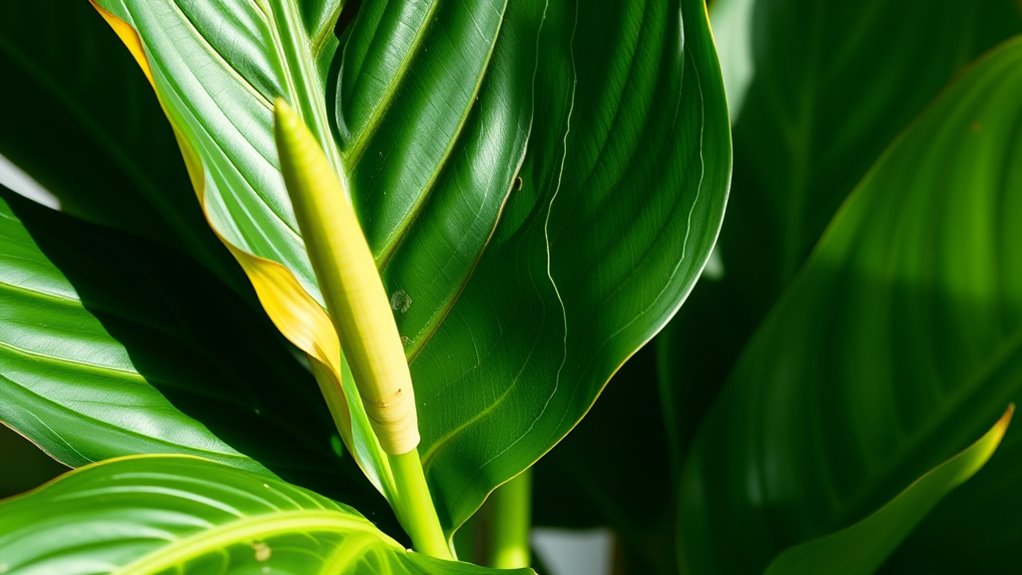
Troubleshooting common growth problems and leaf issues is essential for keeping your Monstera healthy and vibrant. Yellow leaves and leaf browning often signal overwatering, underwatering, or low humidity, so adjust your watering schedule and increase humidity if needed.
If your Monstera lacks leaf splits or fenestrations, it may not be getting enough bright, indirect light.
Curling or wilting leaves indicate environmental stress from drafts, inconsistent watering, or low humidity, which you should address promptly.
Black or soft stems could mean root rot caused by overwatering—remove affected parts and improve drainage.
Pests like scale, mealybugs, or spider mites can damage leaves and cause discoloration; treat early with insecticidal soap or neem oil to prevent further issues.
Frequently Asked Questions
How Do You Encourage Growth in Monstera Deliciosa?
To encourage growth in your Monstera deliciosa, make sure it gets bright, indirect sunlight to boost leaf size and fenestration.
Water when the topsoil feels dry, ensuring you don’t overwater.
Use well-draining, nutrient-rich soil to support healthy roots.
Regularly fertilize every few weeks during the growing season, and consider installing a moss pole or support to help it climb and develop larger, more fenestrated leaves.
How to Make Monstera Deliciosa Thrive?
You might think that just watering your monstera is enough, but it actually thrives with proper light, humidity, and support. Guarantee it gets bright, indirect sunlight for at least 6 hours daily.
Keep humidity around 60%. Water when the topsoil is dry, and support its climbing nature with moss poles.
Regular fertilizing and pruning also help, making your monstera truly thrive and develop those iconic fenestrations.
How to Get Monstera to Grow Fuller?
If you want your monstera to grow fuller, make sure it gets plenty of bright, indirect light.
Regularly prune any leggy or sparse stems to encourage denser foliage.
Feed it with balanced fertilizer every few weeks during the growing season.
Propagate new plants from stem cuttings with aerial roots, and support climbing with moss poles or trellises to stimulate upward growth and encourage a lush, full appearance.
Do Coffee Grounds Help Monstera?
You’re wondering if coffee grounds help Monstera. They can, in moderation, act as a slow-release fertilizer, providing nitrogen and improving soil acidity, which benefits the plant.
Just make sure to mix the grounds into the soil or compost thoroughly to prevent clumping and over-acidification.
Conclusion
With the right care, your monstera deliciosa can transform your space into a lush jungle paradise, rivaling the most exotic rainforests. Mastering lighting, watering, and humidity turns your plant into a vibrant, unstoppable green marvel. Neglect or mistakes, on the other hand, can turn your lush dream into a sad, withered shadow of what it could be. Follow these tips diligently, and watch your monstera flourish into a breathtaking, jungle-worthy masterpiece!
